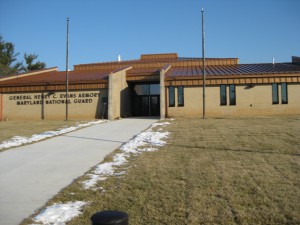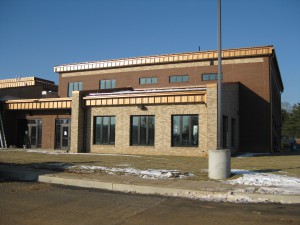Archives
Do You Know DGS? Maryland National Guard Readiness Center in Westminster
DGS delivers a multitude of services to its sister agencies, including design and construction of public facilities. One example is the recently completed expansion and renovation of the Maryland National Guard (MDNG) Readiness Center in Westminster. It provides a glimpse of the commitment and professionalism DGS employees bring to their jobs, as reflected in the numerous steps involved in guiding a design and construction project to successful completion.
The DGS Facilities Planning Design & Construction Division supervises private contractors as they modify, renovate or construct state buildings. The Westminster Readiness Center project came under this division. Each project is assigned a Project Manager (PM), who oversees the work from inception to completion; John Brush, PE, oversaw this project.
Before any phase of the project could get underway, there had to be a committed funding source. The Using Agency (MDNG in this case) requests funds from the Department of Budget and Management (DBM), which then determines what State funds are available. Typically with projects from MDNG, the funding allocation is 25% State funds and 75% Federal funds. Due to the designation and urgency of this project, the Federal government funded the entire project; however, DBM still had to recommend that the project proceed.
Before a contractor could be hired, John had to complete several steps. First, he worked with the DGS Office of Procurement to prepare and advertise a Request for Proposal (RFP) that included Minority Business Enterprise (MBE) goals. This was followed by a meeting with interested architectural and construction firms where they could ask questions about the project, followed by submittal of their technical proposals, including price proposals. After confirming that the bidding firms met certain qualifications, Procurement selected the one with the lowest bid.
When the project reached the design phase, John met with the architect every two weeks to review the design and ensure that it stayed within the funds allocated for the project. Other state agencies also had roles to play: the Department of the Environment had to approve the sediment/erosion plan, while the Department of Natural Resources needed to sign off on the forestation plan.
This story underscores the critical role of the DGS project manager to keep the project on track. “The project manager has to keep an eye on the project as a whole to ensure that it’s a quality product,” John said. “You provide direction, resolve issues and keep everyone working together for the end goal.
“This is just one of many ways DGS continues to change Maryland for the better.”



 1-888-373-7888
1-888-373-7888 233733
233733